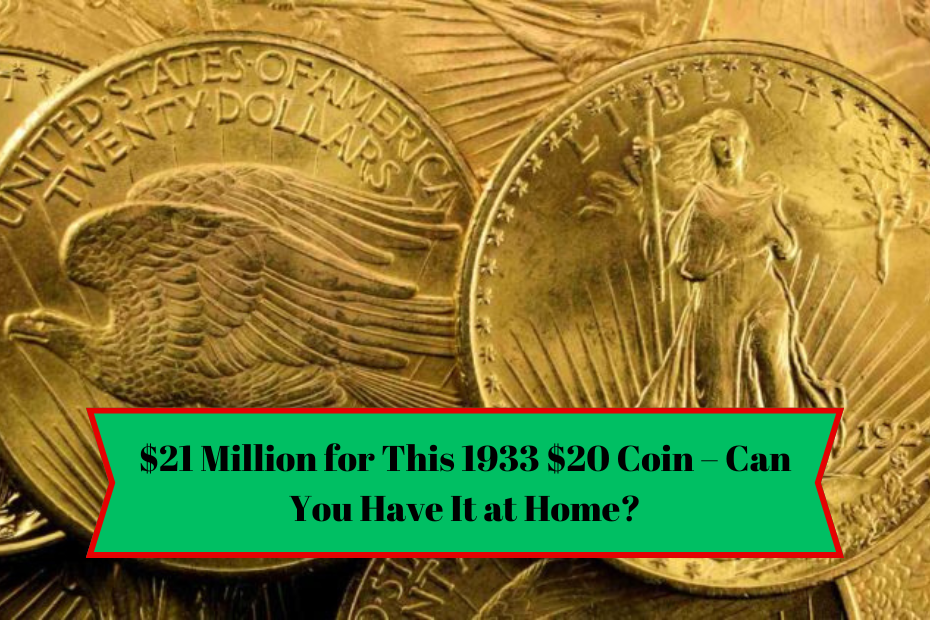$21 million for this 1933 $20 Coin: Is it permissible to possess it at home? A common aspiration of numerous individuals is to unearth an uncommon coin that is concealed in an old drawer or pocket, and which ultimately proves to be worth millions.
Although rare, certain coins have attained legendary status, boasting captivating histories and astonishing price tags. Only three of the 1933 $20 Double Eagles are known to remain in private collections, and they are valued at nearly $21 million today. This coin is one of the most iconic examples.
Origins of the 1933 Double Eagle
This $20 gold coin, which was produced in 1933 during the Great Depression, was never intended for general circulation. In the same year, President Franklin D. Roosevelt issued Executive Order 6102, which prohibited the private ownership of gold, with the exception of objects classified as collectible.
The order, which was subsequently reaffirmed by the Gold Reserve Act of 1934, mandated that citizens exchange their gold coins for paper currency of comparable value. Consequently, in order to bolster the ailing U.S. economy, Double Eagles and numerous other gold coins were withdrawn from circulation and obliterated.
In contrast to coins made of nickel or copper, the Double Eagle was entirely constituted of gold. The coin was particularly susceptible to melting due to its precious metal content, as numerous individuals opted to melt down coins for their gold content rather than risking their illicit possession.
Augustus Saint-Gaudens’ Final Design
The Double Eagle’s allure is substantially enhanced by its design. Augustus Saint-Gaudens, a sculptor who was highly influential in the fields of American art and numismatics.
President Theodore Roosevelt requested the design of the coin in 1907 in order to enhance the artistic quality of U.S. currency. One of Saint-Gaudens’ final contributions to American coinage was the production of this coin, which was completed shortly prior to his demise.
Liberty is depicted on the obverse side of the coin, poised with a torch in her left hand and an olive branch in her right. Her figure is encircled by 46 stars, which were used to represent the states at the time.
The year “1933” is conspicuously stamped below the Capitol building, which is visible in the background. The coin’s reverse side depicts a striking image of an eagle in flight, flying above the beams of a rising sun. The inscriptions “UNITED STATES OF AMERICA,” “TWENTY DOLLARS,” and “IN GOD WE TRUST” are also present.
The Legacy of the Surviving Double Eagles
The precise quantity of 1933 Double Eagles that survived the initial recall is still uncertain. It is believed that approximately 20 of these coins were spared from destruction, and two of them are currently in the possession of the United States.
Smithsonian Museum’s National Numismatic Collection. Furthermore, it is estimated that approximately ten additional coins are stored at Fort Knox’s United States Bullion Depository.
In 2002, a privately held Double Eagle was sold at auction for $7.59 million, making it one of the most renowned of these coins.
The same coin subsequently resurfaced in 2021, achieving an extraordinary $18.9 million at auction, thereby becoming the most valuable gold coin ever sold. The coin’s status as a historical and cultural artifact was underscored by this record-breaking sale.
The 1933 Double Eagle: A Mystery and Its Future
Although a few 1933 Double Eagles have been located, the whereabouts of other potential survivors are still unknown.
According to numerous historians, the majority of these coins were either annihilated, lost to time, or melted down for their gold content.
Nevertheless, the unusual possibility of another Double Eagle resurfacing has sparked speculation regarding its potential value, as it could potentially fetch an auction price that is comparable to the record-breaking $18.9 million sale.

